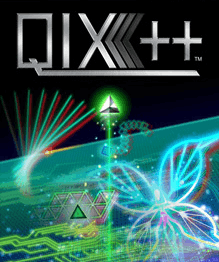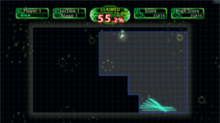Qix++
Qix++[lower-alpha 1] is a video game developed and released by Taito for Xbox Live Arcade on December 9, 2009 and the PlayStation Portable on February 25, 2010 exclusively in Japan. It is the fifth game in the Qix series, and adds several new features, such as different Qix types, powerups, and new enemies.
| Qix++ | |
|---|---|
 Xbox 360 cover art | |
| Developer(s) | Taito |
| Publisher(s) | Taito |
| Composer(s) | Zuntata |
| Series | Qix |
| Platform(s) | Xbox 360, PlayStation Portable |
| Release |
|
| Genre(s) | Puzzle |
| Mode(s) | Single-player, multiplayer |
Gameplay

Qix++ is an action puzzle video game that is similar to its predecessors. The objective of each level is to use a triangle-shaped marker to claim the majority of the playfield, which is accomplished by creating, or "drawing", lines across the screen. When lines connect to the boundary of the playfield, it creates a box on the playfield, indicating that part of the screen has been claimed by the player. Boxes can also be created by connecting lines to pre-existing boxes. The top of the screen indicates the amount of space the player needs to claim in order to progress, measured in percentage. While completing this task, the player will need to avoid the Qix, a create that takes the form of various geometric shapes. The Qix can kill the player with one touch, and can also destroy any lines the player is drawing. The player will also need to avoid the Sparx, deadly balls of lightning that follow the player's lines. Sparx can be defeated by trapping them in boxes.
Qix++ includes multiple additions to the core gameplay. Most stages contain black-colored boxes, which if encased in a box, awards the player a power-up item. Power-ups provide many unique abilities, ranging from those that cause the Qix to shrink in size and slow down, to those that increase the movement speed of the cursor. A multiplayer mode allows four players to battle against each other to be the last person standing, avoiding the Qix and each other's boxes. The Japan-exclusive PlayStation Portable version includes several new gamemodes. These include Float Mode, which creates predetermined boxes on the screen; Hunt Mode, where the player must "trap" the Qix by surrounding it with boxes; and One-Stroke Mode, where the player has to complete the level with one move. The PlayStation Portable version also includes a port of the original Qix arcade game.
Development and release
The soundtrack for Qix++ was composed by Koji Sakurai, a composer known for his work on projects such as Space Invaders Extreme and Energy Air Force. Sakurai is a former member of Zuntata, the "house band" of Taito that worked on many of the company's games since the late 1980's.[1] Zuntata itself assisted in production of the music.[2] Their compositions, which are inspired by abstract and techno, were made to convey the game's unique, futuristic atmosphere.[3]
Reception
| Reception | ||||||||||||||||||||||
|---|---|---|---|---|---|---|---|---|---|---|---|---|---|---|---|---|---|---|---|---|---|---|
| ||||||||||||||||||||||
The Xbox 360 version of Qix++ sold 10,196 units by 2011, while its downloadable content packs sold a combined total of 1,599 units.[11]
The game received mixed to negative reviews from critics. IGN rated the game as 'Poor' and claimed the player would see everything Qix++ had to offer in twenty minutes.
Notes
References
- "「ZUNTATA」結成当時のヨモヤマ話". GA-Core (in Japanese). Try Two. 4 March 2009. Archived from the original on 10 March 2009. Retrieved 2 June 2020.
- "PSP用ソフト「QIX++」のサウンドトラック!". Z-Field (in Japanese). Zuntata. Archived from the original on 6 February 2016. Retrieved 5 June 2020.
- "PSP『QIX++』多彩なゲームモードを収録、オリジナル版もプレイ可能!". Inside-Games (in Japanese). IID, Inc. 2 February 2010. Archived from the original on 7 February 2010. Retrieved 5 June 2020.
- "Qix++ for Xbox 360 Reviews". Metacritic. CBS Interactive. Archived from the original on 8 November 2018. Retrieved 4 June 2020.
- "QIX++ (クイックス プラスプラス) (PSP)". Famitsu (in Japanese). Kadokawa Corporation. Archived from the original on 4 June 2020. Retrieved 4 June 2020.
- VanOrd, Kevin (12 January 2010). "Qix++ Review". GameSpot. CBS Interactive. Archived from the original on 4 June 2020. Retrieved 4 June 2020.
- Hopper, Steven (17 December 2009). "QIX++ Review". GameZone. Archived from the original on 23 December 2009. Retrieved 4 June 2020.
- Gerstmann, Jeff (11 December 2009). "QIX++ Review". Giant Bomb. CBS Interactive. Archived from the original on 2 May 2019. Retrieved 4 June 2020.
- Hatfield, Daemon (9 December 2009). "Qix++ Review". IGN. Archived from the original on 30 March 2019. Retrieved 3 June 2020.
- Price, Tom (9 December 2009). "Qix++ Review (Xbox 360)". TeamXbox. Ziff Davis. Archived from the original on 13 December 2009. Retrieved 4 June 2020.
- Langley, Ryan (20 January 2012). "Xbox Live Arcade by the numbers - the 2011 year in review". Gamasutra. UBM Technology Group. Retrieved 29 April 2020.